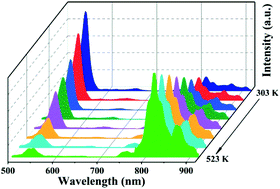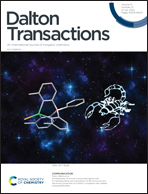Visible and near-infrared luminescence properties of Nd3+/Yb3+ co-doped Gd2O3 phosphors for highly sensitive optical thermometry
Abstract
Phosphors with rare earth (RE) ions are widely applied to optical temperature measurements. Moreover, the near-infrared (NIR) emission of phosphors has potential applications in the biological field. Herein, Gd2O3:x%Nd3+/Yb3+(0.2 ≤ x ≤ 0.8) samples are successfully synthesized by the sol–gel method, and their phase and morphology are characterized. The XRD data are refined by Rietveld. Under 980 nm continuous wave (CW) laser excitation, the upconversion (UC) and downshift (DS) emissions are studied. The temperature sensing performances of thermally coupled levels (TCLs) and non-thermally coupled levels (non-TCLs) of Gd2O3: Nd3+/Yb3+ phosphors are investigated through the fluorescence intensity ratio (FIR) technology. In the temperature range of 303–523 K, the maximum relative sensitivity of I761 nm/I550 nm reaches 6.54% K−1, which is based on non-TCLs. At the same time, the maximum relative sensitivity of I761 nm/I1000 nm–1500 nm reaches 3.13%. In addition, the influence of the laser induced heating (LIH) effect is studied. Compared with square wave (SW) pumping, the relative sensitivity would decrease at CW excitation. Finally, the durability and temperature uncertainty are also discussed. The results prove that the Gd2O3:Nd3+/Yb3+ samples present higher relative sensitivity and durability and lower temperature uncertainty in the biological window. Therefore, the phosphors can be used as optical thermometers in the biological field.



 Please wait while we load your content...
Please wait while we load your content...